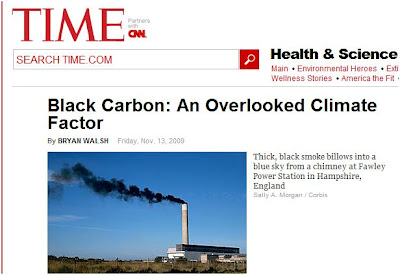 One of the major, albeit contentious, connections has been between black carbon and climate change with an equal weightage to the belief that black carbon does, or not, have a precipitous impact. Where some have seen hope in the ability to tackle black carbon better and faster, other scientists are sceptical that it may just take our eyes of what really needs to be done on climate change, namely bring down CO2 emissions.
One of the major, albeit contentious, connections has been between black carbon and climate change with an equal weightage to the belief that black carbon does, or not, have a precipitous impact. Where some have seen hope in the ability to tackle black carbon better and faster, other scientists are sceptical that it may just take our eyes of what really needs to be done on climate change, namely bring down CO2 emissions.There has been much discussion in the Indian press on a discussion paper put out by the Ministry of Environment that argued that global warming cannot be simply assessed by adding up all emissions and tracking glacier meltdowns.
The TIME Magazine puts out a widely read piece which squarely lines up Black Carbon as the number 2 contributor to climate change. "The world could think that we just cut CO2 and the problem is solved and we all go home, but it's not," says Veerabhadran Ramanathan, a climatologist from the Scripps Institution of Oceanography and an expert on black carbon says in TIME. "That's my nightmare."
"Black carbon in the air actually absorbs sunlight as it comes from space, directly heating up the atmosphere. "The soot particles are like the parts of a blanket, and it's getting thicker," says Ramanathan. "The smoke absorbs sunlight and heats the blanket directly."
All of this has particular importance for developing Asian countries, especially India, where a mix of development means that biomass-burning and diesel combustion remains prominent. Black carbon is already having an impact on the ice atop the Himalayas, the massive glaciers that feed the major rivers of Asia when they melt each spring. Thanks to global warming, these glaciers are receding, threatening the long-term water supplies for the region. Ramanathan, Wilcox and an Indian glaciologist Syed Iqbal Hasnain are working to figure out the impact of black carbon on glacial loss. Beyond warming the atmosphere, black carbon can also speed the melting of glaciers by literally turning them black — soot on snow makes the ice heat up faster. "When black carbon falls on the snow, it darkens it," says Ramanathan. "If the snow is white, it reflects 80% of the sunshine, but with black carbon it absorbs the sunlight."
The good news is that while taking CO2 out of our energy cycle has proven very difficult — especially in poorer developing nations — black-carbon emissions should be easier to curb. Reducing deforestation will help — the burning of tropical rain forests is a big contributor to the black-carbon load.
On the other hand, the Indian Ministry of Environment and Forests paper says that glaciers in the Himalayas, over a period of the last 100 years, behave in contrasting ways. As an example, Sonapani glacier has retreated by about 500m during the last one hundred years. On the other hand, Kangriz glacier has practically not retreated even an inch in the same period. Siachen glacier is believed to have shown an advance of about 700m between 1862 and 1909, followed by an equally rapid retreat
of around 400m between 1929 and 1958, and hardly any retreat during the last 50 years. Gangotri glacier, which had hitherto been showing a rather rapid retreat, along its glacier front, at an average of around 20m per year till up to 2000 AD, has since slowed down considerably, and between September 2007 and June 2009 is practically at a standstill5. The same is true of the Bhagirathkharak and Zemu glaciers.
The auhtors argue that it is premature to make a statement that glaciers in the Himalayas are retreating abnormally because of the global warming. A glacier is affected by a range of physical features and a complex interplay of climatic factors. It is therefore unlikely that the snout movement of any glacier can be claimed to be a result of periodic climate variation until many centuries of observations become available. While glacier movements are primarily due to climate and snowfall, snout movements appear to be peculiar to each particular glacier.

